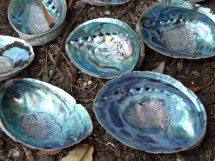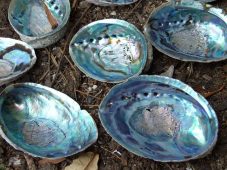Nacre (often called mother of pearl)-the rainbow-sheened material that lines the inside of mollusc shells-has mystified scientists for more than 80 years. Long hailed among the toughest material on earth, its combination of hardness and resilience is stronger than anything yet created by humans using similar chemistry. Now, a team of materials scientists, earth scientists and biologists at the University of Michigan, Australia’s Macquarie University and elsewhere have revealed, for the first time, precisely how the molluscs are so incredibly tough.

Paua shell nacre. Image by Wolfgang K – Wikimedia commons /w/index.php?curid=1732530

Paua shell nacre. Image by Wolfgang K – Wikimedia commons /w/index.php?curid=1732530
Using electron microscopy and micro-indentation techniques at the University of Michigan’s Michigan Center for Materials Characterization, they’ve revealed a nanoscale architecture of organic and inorganic material that combines the best properties of layers and solids, hardness and resilience, into a nearly indestructible supermaterial.
What they’ve found could lead materials scientists to a new generation of ultra-strong synthetic materials for structures, surgical implants and countless other applications. A paper detailing the new discoveries has just been published in Nature Communications.
“Mollusc shells have intrigued generations of scientists,” said Robert Hovden, one of the authors, and an assistant professor of materials science and engineering at the University of Michigan. “But we’ve never before been able to observe how they respond to stress in real time at the nanoscale. This paper, for the first time, shows in vivid detail exactly how the shells respond to impact.”
Researchers have known the basics about nacre for decades-it’s made of microscopic “bricks” of a mineral called aragonite, laced together with a “mortar” made of organic material. This brick-and-mortar arrangement clearly lends strength, but the nacre is far more resilient than its materials suggest. The team, which included Jiseok Gim from the University of Michigan, along with Macquarie University earth scientists Dorrit Jacob and postgraduate student Laura Otter, and colleagues from Université de Bourgogne Franche-Comté and Friedrich-Alexander-University Erlangen-Nürnberg worked together to crack the mystery.
Otter was on a visit to University of Michigan funded by a Macquarie postgraduate research fund during her candidature when she performed the work.
Using tiny piezo-electric micro-indenters, the team was able to exert force on the shells while they were under an electron microscope and watch what happened in real time. They revealed the structure deforms with more complexity than imagined.
They found that the “bricks” are actually multi-sided tablets only a few hundred nanometers in size. Ordinarily, these tablets remain separate, arranged in layers and cushioned by a thin layer of organic “mortar.” But when stress is applied to the shells, the “mortar” squishes aside and the tablets lock together, forming what is essentially a solid surface. When the force is removed, the structure springs back, without losing any strength or resilience.
This resilience sets nacre apart from even the most advanced human-designed materials. Plastics, for example, can spring back from an impact, but they lose some of their strength each time. Nacre lost none of its resilience in repeated impacts at up to 80 per cent of its yield strength.
What’s more, if a crack does form, nacre confines the crack to a single layer rather than allowing it to spread, keeping the shell’s structure intact-the mollusc lives another day. In essence, the material gains its strength by combining the advantages of solid and layered structures.
Co-author Professor Dorrit Jacob, from Macquarie’s University’s Department of Earth and Environmental Sciences, says, “It is fascinating that nature provides us with such complex materials. Mother of pearl continues to inspire engineering of new materials, and we humans still have much to learn about how to mimic these natural materials that currently still outperform any man-made copy.”
Hovden believes humans could use the mussel’s methods to create nano-engineered composite surfaces that could be dramatically lighter and tougher than those available today.
“Nature is handing us these highly optimised structures with millions of years of evolution behind them,” he said. We could never run enough computer simulations to come up with these-they’re just there for us to discover.”
The Mediterranean Pinna nobilis mollusc studied is a protected species due to recent ecological threats, which their shells have unfortunately not evolved to defend against.








